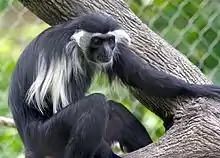Ruwenzori colobus
The Ruwenzori colobus (Colobus angolensis ruwenzorii), also known as Ruwenzori black-and-white colobus, is a subspecies of the Angola colobus.[1] This primate is distributed from the Afromontane forests of the Ruwenzori Mountains across the mountains in Burundi and Rwanda to the northern shore of Lake Tanganyika.[2]
| Ruwenzori black-and-white colobus | |
|---|---|
 | |
| Scientific classification | |
| Domain: | Eukaryota |
| Kingdom: | Animalia |
| Phylum: | Chordata |
| Class: | Mammalia |
| Order: | Primates |
| Suborder: | Haplorhini |
| Infraorder: | Simiiformes |
| Family: | Cercopithecidae |
| Genus: | Colobus |
| Species: | |
| Subspecies: | C. a. ruwenzorii[1] |
| Trinomial name | |
| Colobus angolensis ruwenzorii[1] Thomas, 1901 | |
Taxonomy
In 1901, Oldfield Thomas described two skins of Ruwenzori colobus zoological specimens that were collected at the northwestern slopes of the Ruwenzori Mountains in Bwamba Country of western Uganda. Thomas considered it a species using the scientific name Colobus ruwenzorii.[3]
Characteristics
The Ruwenzori colobus is black with hair on the shoulders between 23 and 33 cm (9.1 and 13.0 in) long. Its tail is also black and greyish-white at the end. It has white bushy tufts on the cheeks.[3] The white hair on the forehead forms a crest.[2]
Distribution and habitat
The Ruwenzori colobus occurs at Lake Nabugabo and Rwenzori Mountains National Park in Uganda.[4] Troops of 300 to 400 individuals inhabit Rwanda's Nyungwe National Park.[5]
Some authors reports indicate that it perhaps also occurs in some Tanzanian regions.[6]
Ecology and behaviour
The Ruwenzori colobus is a highly arboreal and acrobatic leaf-eater. Its diet consists of about two thirds of leaves and one third of fruit and seeds.[7]
Although all Colobus species are very sociable, they usually move on the troops of several hundred animals.[7]
References
- Groves, C. P. (2005). "Colobus angolensis ruwenzorii". In Wilson, D. E.; Reeder, D. M. (eds.). Mammal Species of the World: A Taxonomic and Geographic Reference (3rd ed.). Baltimore: Johns Hopkins University Press. p. 168. ISBN 0-801-88221-4. OCLC 62265494.
- Groves, C. P. (2007). "The taxonomic diversity of the Colobinae of Africa" (PDF). Journal of Anthropological Sciences. 85: 7−34.
- Thomas, O. (1901). "On the more notable Mammals obtained by Sir Harry Johnston in the Uganda Protectorate". Proceedings of the Zoological Society of London. 2 (2): 85−90. doi:10.1111/j.1469-7998.1901.tb08165.x.
- Arseneau-Robar, T. J. M.; Joyce, M. M.; Stead, S. M.; Teichroeb, J. A. (2018). "Proximity and grooming patterns reveal opposite-sex bonding in Rwenzori Angolan colobus monkeys (Colobus angolensis ruwenzorii)". Primates. 59 (3): 267–279. doi:10.1007/s10329-017-0643-6. PMID 29270880. S2CID 1413775.
- Ministère des Terres, de l’Environnement, de l’Eau, des Forêts et des Mines (2005). "Conditions propres aux pays" (PDF). Communication Nationale Initiale relative à la Convention – Cadre des Nations Unies sur les Changements climatiques. Kigali, Rwanda: Republique du Rwanda. pp. 25–48.
{{cite book}}: CS1 maint: multiple names: authors list (link) - Anderson, J.; Cowlishaw, G.; Rowcliffe, J. M. (2007). "Effects of forest fragmentation on the abundance of Colobus angolensis palliatus in Kenya's coastal forests" (PDF). International Journal of Primatology. 28 (3): 637. doi:10.1007/s10764-007-9143-7. S2CID 207151776.
- Philip Briggs; Janice Booth (2010-03-16). Rwanda. ISBN 978-1-84162-306-1.